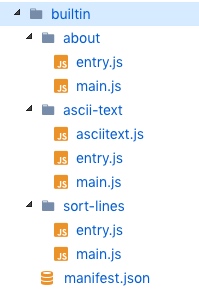JSPower / Marketplace / Develop / About Me
How To Create Your Own Package
JSPower’s builtin utilities are implemented in JavaScript language, for examples, ASCII Text and Sort lines. Source code of them is Here.
This is called a package.

manifest.json contains all required information for the package.
- name/version/author/website/description
- menu items
Tutorial
1) Create GitHub Pages like this one : https://github.com/jspowerx/jspowerx.github.io , and clone packages/helloworld directory.
2) Create manifest.json in packages/helloworld directory, and create directory for each menu item with menu id.
{
"name":"Hell world",
"version":"1.0",
"author":"everettjf",
"website":"https://everettjf.github.io",
"description":"Insert hello world to the end",
"menu":[
{
"id":"hello",
"name":"Hello world"
}
]
}
3) Create entry.js and main.js.
// entry.js
var entry = [
'main.js'
];
// main.js
var onMenuClicked = function(identifier){
invocation.appendLines(['Hello World']);
return {
'result':true
};
};
4) That’s all. Publish your code and Add Package in JSPower macOS App.
More Detail
- Each menu’s JavaScript is run under separated context.
entry.jsdescribes all the JavaScript files and the run order the menu includes.- Menu id can include a
dotfor supply 2 or more menu items in one menu directory. e.g. See the Jump Menu Id
Open Source Packages
The builtin and DLC Pack 1 is opensource under Here
API Document
There are two global variable now, invocation and system.
invocation
getter and setter
1) [getter] invocation.contentUTI
@return string : The Unique Type Identifier (UTI) of the content in the buffer.
2) [getter] invocation.tabWidth
@return integer : The number of space characters represented by a tab character in the buffer.
3) [getter] invocation.indentationWidth
@return integer : The number of space characters used for indentation of the text in the buffer.
4) [getter] invocation.usesTabsForIndentation
@return integer : A Boolean value that indicates whether tabs are used for indentation.
5) [getter] invocation.selectionExist
@return boolean : Whether there is selection of text.
6) [getter,setter] invocation.selections
@return array of array of integer : the 2nd array is always 4 elements, which are [beginLine,beginCol,endLine,endCol]. So the value of selections is
[
[beginLine,beginCol,endLine,endCol],
[beginLine,beginCol,endLine,endCol],
[beginLine,beginCol,endLine,endCol]
]
But in most cases, there is only 1 selection. And the firstSelection came out.
7) [getter] invocation.firstSelection
@return array of integer : always 4 elements.
[beginLine,beginCol,endLine,endCol]
8) [getter] invocation.selectionStrings
@return array of string : All the strings represented by selections. Similar to selections, in most cases there is only 1 string.
9) [getter] invocation.selectionLines
@return array of string : All the strings represented by selections. selectionLines join all the lines represented by selection together.
10) [getter,setter] invocation.completeBuffer
@return string : All the content of current file.
@setter : Assign string to completeBuffer will overwrite the content of current file.
11) [getter,setter] invocation.lines
@return array of strings : All the lines of current file.
@setter : Assign array of strings to lines will overwrite the content of current file.
12) [getter] invocation.lineCount
@return integer : Line count of current file.
method
1) invocation.insertLinesAtIndex(ArrayOfString,Integer)
Insert lines at specified line index.
// Insert 3 lines in front of current file.
invocation.insertLinesAtIndex([
'first line',
'second line',
'third line'
],0);
2) invocation.appendLines(ArrayOfString)
Append lines to the end of current file.
// Append 3 lines to the end of current file.
invocation.appendLines([
'first line',
'second line',
'third line'
]);
3) invocation.removeLinesFromTo(Integer,Integer)
Remove lines from line index to line index.
// Remove lines from index 5 to 10
invocation.removeLinesFromTo(5,10);
4) invocation.assignLineAtIndex(String,Integer)
Assign string to line at index.
// Overwrite the line 1 to 'Hello world'
invocation.assignLineAtIndex('Hello world',1);
system
method
1) system.log(String)
Log string using NSLog.
2) system.openURL(String)
Open URL.
Enjoy :)